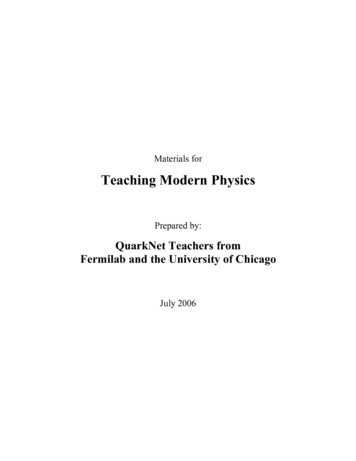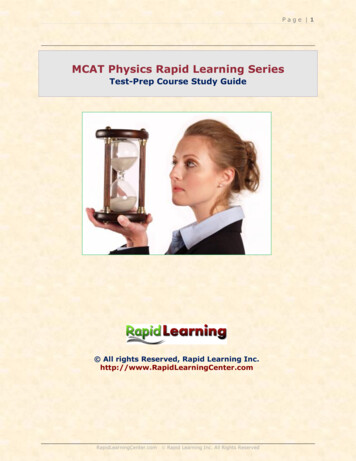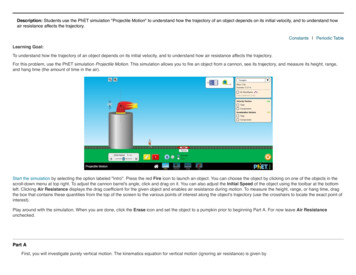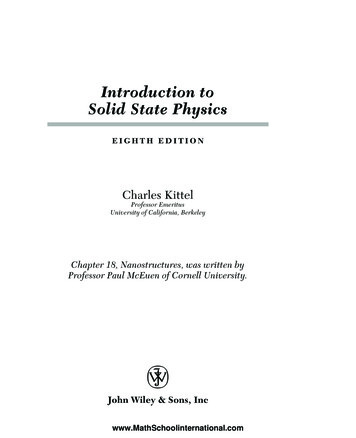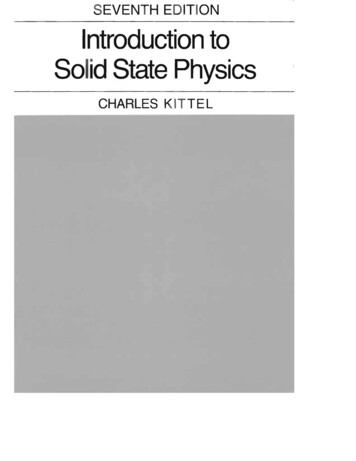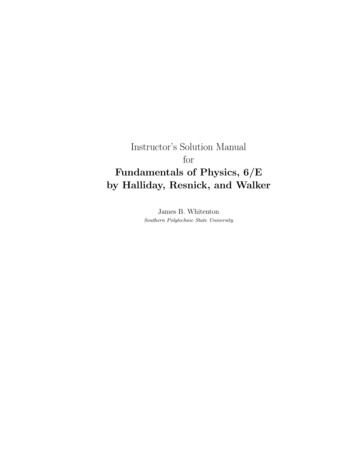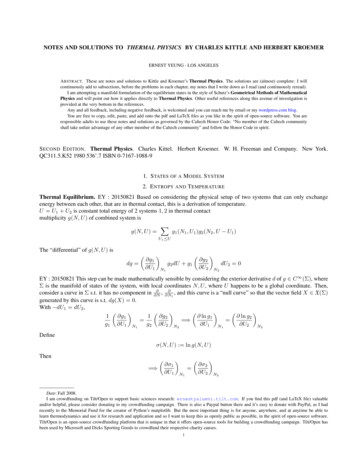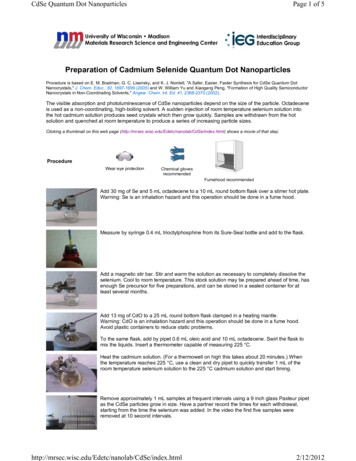
Transcription
Modern PhysicsThird EditionRAYMOND A. SERWAYEmeritusJames Madison UniversityCLEMENT J. MOSESEmeritusUtica College of Syracuse UniversityCURT A. MOYERUniversity of North Carolina-WilmingtonAustralia Canada Mexico Singapore SpainUnited Kingdom United StatesCopyright 2005 Thomson Learning, Inc. All Rights Reserved.
Physics Editor: Chris HallDevelopment Editor: Jay CampbellEditor-in-Chief: Michelle JuletPublisher: David HarrisEditorial Assistant: Seth DobrinTechnology Project Manager: Sam SubityMarketing Manager: Kelley McAllisterMarketing Assistant: Leyla JowzaAdvertising Project Manager: Stacey PurvianceProject Manager, Editorial Production: Teri HydePrint/Media Buyer: Barbara BrittonPermissions Editor: Sarah HarkraderProduction Service: Progressive Publishing AlternativesText Designer: Patrick DevineArt Director: Rob HugelPhoto Researcher: Dena Digilio-BetzCopy Editor: Progressive Publishing AlternativesIllustrator: Rolin Graphics/Progressive InformationTechnologiesCover Designer: Patrick DevineCover Image: Patrice Loiez, CERN/Science PhotoLibrary, Artificially colored bubble chamber photofrom CERN, the European particle physics laboratoryoutside Geneva (1984).Cover Printer: Coral Graphic ServicesCompositor: Progressive Information TechnologiesPrinter: Quebecor World, TauntonCOPYRIGHT 2005, 1997, 1989 by Raymond A. Serway.Brooks/Cole — Thomson Learning10 Davis DriveBelmont, CA 94002USAALL RIGHTS RESERVED. No part of this work covered bythe copyright hereon may be reproduced or used in anyform or by any means — graphic, electronic, or mechanical,including but not limited to photocopying, recording, taping, Web distribution, information networks, or information storage and retrieval systems — without the written permission of the publisher.Printed in the United States of America1 2 3 4 5 6 7 08 07 06 05 04For more information about our products, contact us at:Thomson Learning Academic Resource Center1-800-423-0563For permission to use material from this textor product, submit a request online athttp://www.thomsonrights.com.Any additional questions about permissions can besubmitted by email to thomsonrights@thomson.com.Library of Congress Control Number: 2004101232Student’s Edition: ISBN 0-534-49339-4International Student Edition: ISBN 0-534-40624-6AsiaThomson Learning5 Shenton Way #01-01UIC BuildingSingapore 068808Australia/New ZealandThomson Learning102 Dodds StreetSouthbank, Victoria 3006AustraliaCanadaNelson1120 Birchmount RoadToronto, Ontario M1K 5G4CanadaEurope/Middle East/AfricaThomson LearningHigh Holborn House50/51 Bedford RowLondon WC1R 4LRUnited KingdomLatin AmericaThomson LearningSeneca, 53Colonia Polanco11560 Mexico D.F.MexicoSpain/PortugalParaninfoCalle/Magallanes, 2528015 Madrid, SpainCopyright 2005 Thomson Learning, Inc. All Rights Reserved.
About the AuthorsRaymond A. Serway received his doctorate at Illinois Institute of Technology andis Professor Emeritus at James Madison University. Dr. Serway began his teachingcareer at Clarkson University, where he conducted research and taught from1967 to 1980. His second academic appointment was at James Madison University as Professor of Physics and Head of the Physics Department from 1980 to1986. He remained at James Madison University until his retirement in 1997. Hewas the recipient of the Madison Scholar Award at James Madison University in1990, the Distinguished Teaching Award at Clarkson University in 1977, and theAlumni Achievement Award from Utica College in 1985. As Guest Scientist at theIBM Research Laboratory in Zurich, Switzerland, he worked with K. Alex Müller,1987 Nobel Prize recipient. Dr. Serway also held research appointments at RomeAir Development center from 1961 to 1963, at IIT Research Institute from 1963to 1967, and as a visiting scientist at Argonne National Laboratory, where he collaborated with his mentor and friend, Sam Marshall. In addition to earlier editions of this textbook, Dr. Serway is the co-author of Physics for Scientists and Engineers, 6th edition, Principles of Physics, 3rd edition, College Physics, 6th edition, andthe high-school textbook Physics, published by Holt, Rinehart, and Winston. Inaddition, Dr. Serway has published more than 40 research papers in the field ofcondensed matter physics and has given more than 60 presentations at professional meetings. Dr. Serway and his wife Elizabeth enjoy traveling, golfing, fishing, and spending quality time with their four children and seven grandchildren.Clement J. Moses is Emeritus Professor of Physics at Utica College. He wasborn and brought up in Utica, New York, and holds an A.B. from HamiltonCollege, an M.S. from Cornell University, and a Ph.D. from State University ofNew York at Binghamton. He has over 30 years of science writing and teachingexperience at the college level, and is a co-author of College Physics, 6th edition,with Serway and Faughn. His research work, both in industrial and universitysettings, has dealt with defects in solids, solar cells, and the dynamics of atomsat surfaces. In addition to science writing, Dr. Moses enjoys reading novels,gardening, cooking, singing, and going to operas.Curt A. Moyer has been Professor and Chair of the Department of Physics andPhysical Oceanography at the University of North Carolina-Wilmington since1999. Before his appointment to UNC-Wilmington, he taught in the PhysicsDepartment at Clarkson University from 1974 to 1999. Dr. Moyer earned a B.S.from Lehigh University and a Ph.D. from the State University of New York atStony Brook. He has published more than 45 research articles in the fields ofcondensed matter physics and surface science. In addition to being an experienced teacher, Dr. Moyer is an advocate for the uses of computers in education and developed the Web-based QMTools software that accompanies thistext. He and his wife, V. Sue, enjoy traveling and the special times they spendwith their four children and three grandchildren.iiiCopyright 2005 Thomson Learning, Inc. All Rights Reserved.
PrefaceThis book is intended as a modern physics text for science majors and engineering students who have already completed an introductory calculus-basedphysics course. The contents of this text may be subdivided into two broad categories: an introduction to the theories of relativity, quantum and statisticalphysics (Chapters 1 through 10) and applications of elementary quantum theory to molecular, solid-state, nuclear, and particle physics (Chapters 11through 16).OBJECTIVESOur basic objectives in this book are threefold:1. To provide simple, clear, and mathematically uncomplicated explanations of physical concepts and theories of modern physics.2. To clarify and show support for these theories through a broad range ofcurrent applications and examples. In this regard, we have attempted toanswer questions such as: What holds molecules together? How do electrons tunnel through barriers? How do electrons move through solids?How can currents persist indefinitely in superconductors?3. To enliven and humanize the text with brief sketches of the historical development of 20th century physics, including anecdotes and quotationsfrom the key figures as well as interesting photographs of noted scientistsand original apparatus.COVERAGETopics. The material covered in this book is concerned with fundamentaltopics in modern physics with extensive applications in science and engineering. Chapters 1 and 2 present an introduction to the special theory of relativity. Chapter 2 also contains an introduction to general relativity. Chapters 3through 5 present an historical and conceptual introduction to early developments in quantum theory, including a discussion of key experiments that showthe quantum aspects of nature. Chapters 6 through 9 are an introduction tothe real “nuts and bolts” of quantum mechanics, covering the Schrödingerequation, tunneling phenomena, the hydrogen atom, and multielectronivCopyright 2005 Thomson Learning, Inc. All Rights Reserved.
PREFACEatoms, while Chapter 10 contains an introduction to statistical physics. The remainder of the book consists mainly of applications of the theory set forth inearlier chapters to more specialized areas of modern physics. In particular,Chapter 11 discusses the physics of molecules, while Chapter 12 is an introduction to the physics of solids and electronic devices. Chapters 13 and 14 covernuclear physics, methods of obtaining energy from nuclear reactions,and medical and other applications of nuclear processes. Chapter 15 treatselementary particle physics, and Chapter 16 (available online at http://info.brookscole.com/mp3e) covers cosmology.CHANGES TO THE THIRD EDITIONThe third edition contains two major changes from the second edition: First,this edition has been extensively rewritten in order to clarify difficult concepts,aid understanding, and bring the text up to date with rapidly developing technical applications of quantum physics. Artwork and the order of presentationof certain topics have been revised to help in this process. (Many new photosof physicists have been added to the text, and a new collection of color photographs of modern physics phenomena is also available on the Book Companion Web Site.) Typically, each chapter contains new worked examples andfive new end-of-chapter questions and problems. Finally, the Suggestions for Further Reading have been revised as needed.Second, this edition refers the reader to a new, online (platform independent) simulation package, QMTools, developed by one of the authors, CurtMoyer. We think these simulations clarify, enliven, and complement the analytical solutions presented in the text. Icons in the text highlight the problemsdesigned for use with this software, which provides modeling tools to help students visualize abstract concepts. All instructions about the general use of thesoftware as well as specific instructions for each problem are contained on theBook Companion Web Site, thereby minimizing interruptions to the logicalflow of the text. The Book Companion Web Site at http://info.brookscole.mp3e also contains appendices and much supplemental information on current physics research and applications, allowing interested readers to digdeeper into many topics.Specific changes by chapter in this third edition are as follows: Chapter 1 in the previous editions, “Relativity,” has been extensively revisedand divided into two chapters. The new Chapter 1, entitled “Relativity I,”contains the history of relativity, new derivations of the Lorentz coordinateand velocity transformations, and a new section on spacetime and causality. Chapter 2, entitled “Relativity II,” covers relativistic dynamics and energyand includes new material on general relativity, gravitational radiation,and the applications GPS (Global Positioning System) and LIGO (theLaser Interferometer Gravitational-wave Observatory). Chapter 3 has been streamlined with a more concise treatment of theRayleigh-Jeans and Planck blackbody laws. Material necessary for a complete derivation of these results has been placed on our Book CompanionWeb Site. Chapter 5 contains a new section on the invention and principles of operation of transmission and scanning electron microscopes.Copyright 2005 Thomson Learning, Inc. All Rights Reserved.v
viPREFACE Chapter 6, “Quantum Mechanics in One Dimension,” features a newapplication on the principles of operation and utility of CCDs (ChargeCoupled Devices).Chapter 8, “Quantum Mechanics in Three Dimensions,” includes a newdiscussion on the production and spectroscopic study of anti-hydrogen, astudy which has important consequences for several fundamental physicalquestions.Chapter 10 presents new material on the connection of wavefunctionsymmetry to the Bose-Einstein condensation and the Pauli exclusion principle, as well as describing potential applications of Bose-Einstein condensates.Chapter 11 contains new material explaining Raman scattering, fluorescence, and phosphorescence, as well as giving applications of theseprocesses to pollution detection and biomedical research. This chapterhas also been streamlined with the discussion of overlap integrals beingmoved to the Book Companion Web Site.Chapter 12 has been carefully revised for clarification and features newmaterial on semiconductor devices, in particular MOSFETs and chips. Inaddition, the most important facts about superconductivity have beensummarized, updated, and included in Chapter 12. For those desiringmore material on superconductivity, the entire superconductivity chapterfrom previous editions is available at the Book Companion Web Sitealong with essays on the history of the laser and solar cells.Chapter 13 contains new material on MRI (Magnetic Resonance Imaging) and an interesting history of the determination of the age of theEarth.Chapter 14 presents updated sections on fission reactor safety and wastedisposal, fusion reactor results, and applications of nuclear physics totracing, neutron activation analysis, radiation therapy, and other areas.Chapter 15 has been extensively rewritten in an attempt to convey thethrust toward unification in particle physics. By way of achieving this goal,new discussions of positrons, neutrino mass and oscillation, conservationlaws, and grand unified theories, including supersymmetry and string theory, have been introduced.Chapter 16 is a new chapter devoted exclusively to the exciting topic ofthe origin and evolution of the universe. Topics covered include the discovery of the expanding universe, primordial radiation, inflation, the future evolution of the universe, dark matter, dark energy, and the accelerating expansion of the universe. This cosmology chapter is available onour Book Companion Web Site.FEATURES OF THIS TEXTQMTools Five chapters contain several new problems requiring the use ofour simulation software, QMTools. QMTools is a sophisticated interactive learning tool with considerable flexibility and scope. Using QMTools, students cancompose matter-wave packets and study their time evolution, find stationarystate energies and wavefunctions, and determine the probability for particletransmission and reflection from nearly any potential well or barrier. Access toQMTools is available online at http://info.brookscole.com/mp3e.Copyright 2005 Thomson Learning, Inc. All Rights Reserved.
PREFACEStyle. We have attempted to write this book in a style that is clear and succinct yet somewhat informal, in the hope that readers will find the text appealing and enjoyable to read. All new terms have been carefully defined, and wehave tried to avoid jargon.Worked Examples. A large number of worked examples of varying difficultyare presented as an aid in understanding both concepts and the chain of reasoning needed to solve realistic problems. In many cases, these examples willserve as models for solving some end-of-chapter problems. The examples areset off with colored bars for ease of location, and most examples are given titles to describe their content.Exercises Following Examples. As an added feature, many of the workedexamples are followed immediately by exercises with answers. These exercisesare intended to make the textbook more interactive with the student, andto test immediately the student’s understanding of key concepts and problemsolving techniques. The exercises represent extensions of the worked examplesand are numbered in case the instructor wishes to assign them for homework.Problems and Questions. An extensive set of questions and problems is included at the end of each chapter. Most of the problems are listed by sectiontopic. Answers to all odd-numbered problems are given at the end of thebook. Problems span a range of difficulty and more challenging problemshave colored numbers. Most of the questions serve to test the student’s understanding of the concepts presented in a given chapter, and many can be usedto motivate classroom discussions.Units. The international system of units (SI) is used throughout the text.Occasionally, where common usage dictates, other units are used (such as theangstrom, Å, and cm 1, commonly used by spectroscopists), but all such unitsare carefully defined in terms of SI units.Chapter Format. Each chapter begins with a preview, which includes a briefdiscussion of chapter objectives and content. Marginal notes set in color are usedto locate important concepts and equations in the text. Important statements areitalicized or highlighted, and important equations are set in a colored box foradded emphasis and ease of review. Each chapter concludes with a summary,which reviews the important concepts and equations discussed in that chapter.In addition, many chapters contain special topic sections which are clearlymarked optional. These sections expose the student to slightly more advancedmaterial either in the form of current interesting discoveries or as fuller developments of concepts or calculations discussed in that chapter. Many of thesespecial topic sections will be of particular interest to certain student groupssuch as chemistry majors, electrical engineers, and physics majors.Guest Essays. Another feature of this text is the inclusion of interesting material in the form of essays by guest authors. These essays cover a wide range oftopics and are intended to convey an insider’s view of exciting current developments in modern physics. Furthermore, the essay topics present extensionsand/or applications of the material discussed in specific chapters. Some of theCopyright 2005 Thomson Learning, Inc. All Rights Reserved.vii
viiiPREFACEessay topics covered are recent developments in general relativity, the scanning tunneling microscope, superconducting devices, the history of the laser,laser cooling of atoms, solar cells, and how the top quark was detected. Theguest essays are either included in the text or referenced as being on our Website at appropriate points in the text.Mathematical Level. Students using this text should have completed a comprehensive one-year calculus course, as calculus is used throughout the text.However, we have made an attempt to keep physical ideas foremost so as not toobscure our presentations with overly elegant mathematics. Most steps are shownwhen basic equations are developed, but exceptionally long and detailed proofswhich interrupt the flow of physical arguments have been placed in appendices.Appendices and Endpapers. The appendices in this text serve several purposes. Lengthy derivations of important results needed in physical discussionshave been placed on our Web site to avoid interrupting the main flow of arguments. Other appendices needed for quick reference are located at the end ofthe book. These contain physical constants, a table of atomic masses, and a listof Nobel prize winners. The endpapers inside the front cover of the book contain important physical constants and standard abbreviations of units used inthe book, and conversion factors for quick reference, while a periodic table isincluded in the rear cover endpapers.Ancillaries. The ancillaries available with this text include a Student Solutions Manual, which has solutions to all odd-numbered problems in the book,an Instructor’s Solutions Manual, consisting of solutions to all problems in thetext, and a Multimedia Manager, a CD-ROM lecture tool that contains digitalversions of all art and selected photographs in the text.TEACHING OPTIONSAs noted earlier, the text may be subdivided into two basic parts: Chapters 1through 10, which contain an introduction to relativity, quantum physics, andstatistical physics, and Chapters 11 through 16, which treat applications tomolecules, the solid state, nuclear physics, elementary particles, and cosmology. It is suggested that the first part of the book be covered sequentially. However, the relativity chapters may actually be covered at any time because E 2 p 2c 2 m2c4 is the only formula from these chapters which is essential for subsequent chapters. Chapters 11 through 16 are independent of one anotherand can be covered in any order with one exception: Chapter 14, “NuclearPhysics Applications,” should follow Chapter 13, “Nuclear Structure.”A traditional sophomore or junior level modern physics course for science,mathematics, and engineering students should cover most of Chapters 1through 10 and several of the remaining chapters, depending on the studentmajor. For example, an audience consisting mainly of electrical engineering students might cover most of Chapters 1 through 10 with particular emphasis ontunneling and tunneling devices in Chapter 7, the Fermi-Dirac distribution inChapter 10, semiconductors in Chapter 12, and radiation detectors in Chapter14. Chemistry and chemical engineering majors could cover most of Chapters 1through 10 with special emphasis on atoms in Chapter 9, classical and quantumCopyright 2005 Thomson Learning, Inc. All Rights Reserved.
PREFACEstatistics in Chapter 10, and molecular bonding and spectroscopy in Chapter 11.Mathematics and physics majors should pay special attention to the unique development of operator methods and the concept of sharp and fuzzy observablesintroduced in Chapter 6. The deep connection of sharp observables with classically conserved quantities and the powerful role of sharp observables in shapingthe form of system wavefunctions is developed more fully in Chapter 8.Our experience has shown that there is more material contained in thisbook than can be covered in a standard one semester three-credit-hourcourse. For this reason, one has to “pick-and-choose” from topics in the second part of the book as noted earlier. However, the text can also be used in atwo-semester sequence with some supplemental material, such as one of manymonographs on relativity, and/or selected readings in the areas of solid state,nuclear, and elementary particle physics. Some selected readings are suggested at the end of each chapter.ACKNOWLEDGMENTSWe wish to thank the users and reviewers of the first and second editions whogenerously shared with us their comments and criticisms. In preparing thisthird edition we owe a special debt of gratitude to the following reviewers:Melissa Franklin, Harvard UniversityEdward F. Gibson, California State University, SacramentoGrant Hart, Brigham Young UniversityJames Hetrick, University of the PacificAndres H. La Rosa, Portland State UniversityPui-tak (Peter) Leung, Portland State UniversityPeter Moeck, Portland State UniversityTimothy S. Sullivan, Kenyon CollegeWilliam R. Wharton, Wheaton CollegeWe thank the professional staff at Brooks-Cole Publishing for their fine workduring the development and production of this text, especially Jay Campbell,Chris Hall, Teri Hyde, Seth Dobrin, Sam Subity, Kelley McAllister, StaceyPurviance, Susan Dust Pashos, and Dena Digilio-Betz. We thank Suzon O.Kister for her helpful reference work, and all the authors of our guest essays:Steven Chu, Melissa Franklin, Roger A. Freedman, Clark A. Hamilton, Paul K.Hansma, David Kestenbaum, Sam Marshall, John Meakin, and Clifford M. Will.Finally, we thank all of our families for their patience and continual support.Raymond A. SerwayLeesburg, VA 20176Clement J. MosesDurham, NC 27713Curt A. MoyerWilmington, NC 28403December 2003Copyright 2005 Thomson Learning, Inc. All Rights Reserved.ix
Contents Overview1 Relativity I12 Relativity II413 The Quantum Theory of Light654 The Particle Nature of Matter1065 Matter Waves1516 Quantum Mechanics in One Dimension1917 Tunneling Phenomena 2318 Quantum Mechanics in Three Dimensions9 Atomic Structure29510 Statistical Physics33411 Molecular Structure12 The Solid State26037240413 Nuclear Structure46314 Nuclear Physics Applications15 Elementary Particles50354716 Cosmology (Web Only)Appendix ABest Known Values for Physical ConstantsAppendix BTable of Selected Atomic MassesAppendix CNobel PrizesA.7Answers to Odd-Numbered ProblemsIndexI.1xCopyright 2005 Thomson Learning, Inc. All Rights Reserved.A.12A.2A.1
Contents11.11.2RELATIVITY I3 THE QUANTUM THEORYOF LIGHT 65Special Relativity 2The Principle of RelativityThe Speed of Light1.3133.16The Michelson – Morley Experiment73.2Details of the Michelson – MorleyExperiment 81.41.5Enter Planck 72The Quantum of EnergyPostulates of Special Relativity 10Consequences of Special Relativity 13Simultaneity and the Relativity of TimeTime Dilation 15Length Contraction 18The Twins Paradox (Optional) 21The Relativistic Doppler Shift 221.6The Lorentz IVITY II 41Relativistic Momentum andthe Relativistic Formof Newton’s Laws 41Relativistic Energy 44Mass as a Measure of Energy 48Conservation of RelativisticMomentum and Energy 52General Relativity 5377Light Quantization and the PhotoelectricEffect 80The Compton Effect and X-Rays 86X-Rays 86The Compton Effect893.6Particle – Wave Complementarity 943.7Does Gravity Affect Light? (Optional) 95Summary 98Web Appendix Calculation of the Number of Modesof Waves in a CavityPlanck’s Calculation of the AverageEnergy of an Oscillator4 THE PARTICLE NATUREOF MATTER 1064.14.2Gravitational Radiation, or a Good WaveIs Hard to Find 56Summary 59Web Essay The Renaissance of General RelativityClifford M. Will74The Rayleigh–Jeans Law and Planck’sLaw (Optional) 77Rayleigh–Jeans LawPlanck’s Law 79Lorentz Velocity Transformation 291.7 Spacetime and CausalitySummary 35Hertz’s Experiments—Light as anElectromagnetic Wave 66Blackbody Radiation 68The Atomic Nature of Matter 106The Composition of Atoms 108Millikan’s Value of the Elementary Charge 113Rutherford’s Model of the Atom 1194.3The Bohr Atom125Spectral Series 126Bohr’s Quantum Model of the Atom130xiCopyright 2005 Thomson Learning, Inc. All Rights Reserved.
xiiCONTENTS4.4Bohr’s Correspondence Principle,or Why Is Angular MomentumQuantized? 1394.5Direct Confirmation of Atomic EnergyLevels: The Franck – Hertz ExperimentSummary 1435 MATTER WAVES5.1The Pilot Waves of De Broglie5.55.65.7Field Emission 239 Decay 242Ammonia Inversion 245Decay of Black Holes 247Summary 248Essay The Scanning Tunneling MicroscopeRoger A. Freedman and Paul K. Hansma 2531521538 QUANTUM MECHANICS INTHREE DIMENSIONS 260159Wave Groups and DispersionMatter Wave Packets5.4141164169Fourier Integrals (Optional)170Constructing Moving Wave Packets1738.18.2The Heisenberg Uncertainty Principle173A Different View of the Uncertainty Principle175If Electrons Are Waves, What’sWaving? 178The Wave–Particle Duality 179The Description of ElectronDiffraction in Terms of 179A Thought Experiment: MeasuringThrough Which Slit the Electron Passes5.8A Final NoteSummary 1868.38.46.48.51848.6AntihydrogenSummary 289The Born Interpretation 191Wavefunction for a Free ParticleWavefunctions in the Presenceof Forces 197The Particle in a Box 200194205The Finite Square Well (Optional)The Quantum Oscillator 212Expectation Values 217Observables and Operators 221209Quantum Uncertainty and the Eigenvalue Property(Optional) 222SummaryAtomic Hydrogen and Hydrogen-likeIons 277The Ground State of Hydrogen-like Atoms 282Excited States of Hydrogen-like Atoms 284186Charge-Coupled Devices (CCDs)6.56.66.76.8Particle in a Three-Dimensional Box 260Central Forces and AngularMomentum 266Space Quantization 271Quantization of Angular Momentum andEnergy (Optional) 273Lz Is Sharp: The Magnetic Quantum Number 275兩L兩 Is Sharp: The Orbital Quantum Number 276E Is Sharp: The Radial Wave Equation 2766 QUANTUM MECHANICS INONE DIMENSION 1916.16.26.3The Square Barrier 231Barrier Penetration: SomeApplications 238The Davisson–Germer Experiment 154The Electron Microscope5.37.17.2151De Broglie’s Explanation ofQuantization in the Bohr Model5.27 TUNNELING PHENOMENA 231224Copyright 2005 Thomson Learning, Inc. All Rights Reserved.99.1287ATOMIC STRUCTURE295Orbital Magnetism and theNormal Zeeman Effect 2969.2The Spinning Electron 3029.3The Spin – Orbit Interaction andOther Magnetic Effects 3099.4Exchange Symmetry and theExclusion Principle 3129.5Electron Interactions and ScreeningEffects (Optional) 3169.6The Periodic Table 3199.7X-Ray Spectra and Moseley’s Law 325Summary 328
CONTENTS1010.1STATISTICAL PHYSICS334The Maxwell – Boltzmann Distribution33512 THE SOLID STATE12.1The Maxwell Speed Distribution forGas Molecules in Thermal Equilibrium atTemperature T 341The Equipartition of Energy 34310.210.310.4Under What Physical Conditions AreMaxwell – Boltzmann StatisticsApplicable? 344Quantum Statistics 34612.212.3Applications of Bose – EinsteinStatistics 35112.412.5420377Molecular Rotation 378Molecular Vibration 381Molecular Spectra 385Electron Sharing and theCovalent Bond 390The Hydrogen Molecular Ion 390The Hydrogen Molecule 39611.5Bonding in Complex Molecules(Optional) 397Summary 399Web Appendix Overlap Integrals of AtomicWavefunctionsCopyright 2005 Thomson Learning, Inc. All Rights Reserved.425Semiconductor Devices433SuperconductivityLasers 447443Absorption, Spontaneous Emission,and Stimulated Emission 447Population Inversion and Laser ActionSemiconductor Lasers 451Bonding Mechanisms: A Survey 373Ionic Bonds 374Covalent Bonds 374van der Waals Bonds 375The Hydrogen Bond 377Band Theory of SolidsThe p -n Junction 433Light-Emitting and -AbsorbingDiodes — LEDs and Solar Cells 436The Junction Transistor 437The Field-Effect Transistor (FET) 439The Integrated Circuit 44112.612.711 MOLECULARSTRUCTURE 37211.311.4Quantum Theory of MetalsIsolated-Atom Approach to Band Theory 425Conduction in Metals, Insulators, andSemiconductors 426Energy Bands from Electron Wave Reflections 429352Molecular Rotation and VibrationClassical Free Electron Modelof Metals 413Replacement of vrms with vF 421Wiedemann – Franz Law Revisited 422Quantum Mean Free Path of Electrons 423An Application of Fermi – Dirac Statistics:The Free-Electron Gas Theoryof Metals 356Summary 360Essay Laser Manipulation of AtomsSteven Chu 36611.2405Ohm’s Law 414Classical Free Electron Theoryof Heat Conduction 41810.511.1404Ionic Solids 4
neers, 6th edition, Principles of Physics, 3rd edition, College Physics, 6th edition, and the high-school textbook Physics, published by Holt, Rinehart, and Winston. In addition, Dr. Serway has published more than 40 research papers in the field of condensed matter physics and has given

